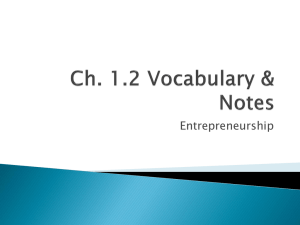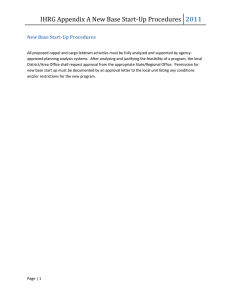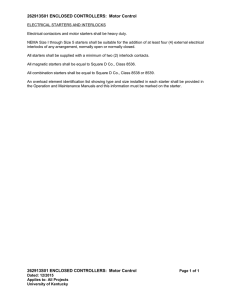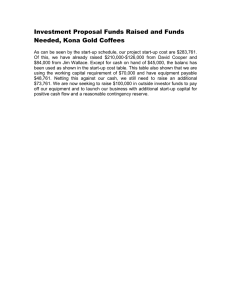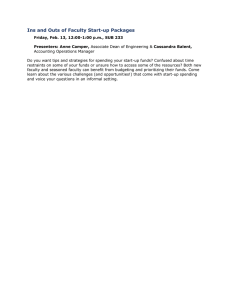Motor starting – conservation of resources Motor starting
advertisement
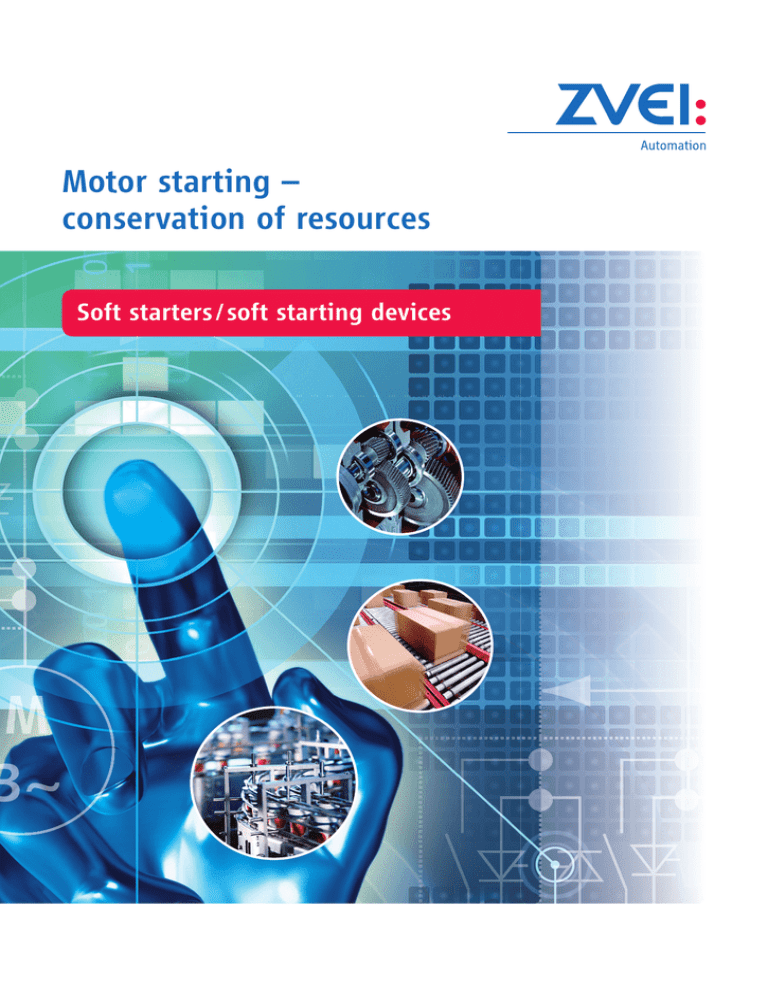
M 3~ Motor starting – L3 conservation of resources Soft starters / soft starting devices M OTO R S TA R T I N G – R E S O U R C E P R OT E C T I O N Motor and machine Since its invention fare more than a decade ago, the three-phase motor has increasingly established itself as drive unit. Today, it represents the most frequently employed electric drive. G1 Direct switch-on of electric motors basically bears two disadvantageous effects: Inrush currents up to 7 times higher than the nominal current and torques increased by up to factor 3. The increased torque results in sudden mechanical stress on the machine which leads to a reduced service life. Moreover, the high inrush current stresses the power supply, which may lead to voltage dips. As a result, the operability of sensitive consumers may be impaired. Motor start-up – it comes down to the right method! The increasing establishment of three-phase motors on the market entailed a growing demand for a soft start-up behavior in order to eliminate the above-mentioned undesired side effects. Solution concepts based on electric measures in terms of mains supply and mechanical processes such as slip clutches were developed. The list provides an overview of the various electric start-up types. The current and torque characteristic curves show the behavior of the respective starter solution. L1 Characteristics: Direct start-up • Three-phase motor of low to medium power rating • 3 conductors to the motor • High starting torque • High current peak • Voltage dip • One simple switch-gear device L2 U L1 -L Star-delta start-up • Three-phase motor with low to high power rating • 6 conductors to the motor • Reduced starting torque, 1/3 of the nominal torque • High mains load due to current peak during switchover from Y to ∆ • High mechanical stress due to torque surge during switchover from Y to ∆ • Many maintenance-intensive switch-gear devices Soft start-up • Three-phase motor with low to high power rating • 3 conductors to the motor • Variable starting torque • No current peak • No torque peaks • Negligible voltage dip • One simple switching device • Optional: Guided soft stop, protective functions, etc. • Zero maintenance M Comparison of the various starter methods Motor voltage Direct U Star-delta Soft starter 100 % 58 % 70 % adjustable start voltage und start time 30 % Time I Motor current T t Torque Direct L3 Direct Star-delta Star-delta Soft starter Soft starter n n Motor speed L1 -L3 The graphics show the basic differences between direct, star-delta and soft starters with regard to motor voltage (U), motor current (I) and motor torque (T). Motor speed Compared to contactor solutions, soft starters, sometimes also referred to as soft starting devices, offer considerable advantages. L1 L3 M OTO R S TA R T I N G – R E S O U R C E P R OT E C T I O N The illustrated characteristic curves clearly show torque surges as well as high currents and current peaks of the contactor solutions: • Torque surges cause high mechanical stress on the machine, which results in higher service costs and increased wear. • High currents and current peaks lead to high fixed costs charged by the power supply companies (peak current calculation) and to increased mains and generator loads. A soft starter continuously controls the three-phase motor’s voltage supply during the start-up phase. This way, the motor is adjusted to the machine’s load behavior. Mechanical operating equipment is accelerated in a particularly gentle manner. Service life, operating behavior and production processes are positively influenced. Avoidance of negative influences such as: • Impact of tooth flanks in the gear unit • Reduction of pressure surges in pipelines • Slipping of V-belts • Jerk-effect with transportation equipment G1 EMC made easy: • No shielded motor lines required • No RFI suppression filters required • No sinewave or du/dt filters required The product standard IEC/EN 60 947-4-2 applies to soft starters. Compliance with this standard and corresponding assurance of the high quality standard are documented by the manufacturers’ declaration of conformity. G1 M OTO R S TA R T I N G – R E S O U R C E P R OT E C T I O N Soft starter versions The following versions are generally differentiated: Soft starters for standard tasks: • Mainly employed with low to medium power ratings • As replacement of star-delta combinations • Reduced wiring expenditures • Minimized space requirements • Less possible fault causes • Zero maintenance • For jerk-free operation during the start-up phase • Optional soft stop offers advantages compared to mechanical solutions M 3~ Soft starters for demanding tasks: • Power range up to 1200 kW (compact devices) • Voltage levels 200 / 400 / 500 / 690 V • All devices feature adjustable current limiting for the prevention of peak current loads Further important device characteristics: • • • • • Motor protection functions (optional) Monitoring and protection functions for mains and soft starter Parameterization functions for optimizing the application Control commands (various inputs) Signaling contacts, e.g. for: • Control of an external bridging contactor (reduced power loss during continuous operation) • Monitoring signals • Fault messages (e.g. mains, soft starter, motor) • Communication (optional), e.g. via field bus systems • Inside-delta circuit (for the use of smaller soft starters) • Torque control (optional) for particularly difficult start-up tasks Soft starters with integrated bypass for standard applications and demanding tasks: • Reduced power loss during continuous operation (after start-up) • Compact sizes for reduced space requirements inside the control cabinet U L1 L1L3 α α α L2 L3 U L1 -L3 t G1 M 3~ Phase angle control and schematic design of a soft starter with internal bypass contacts L3 M OTO R S TA R T I N G – R E S O U R C E P R OT E C T I O N Applications of soft starters Soft starters can be setup to the requirements of the individual application. The table below offers an overview of machines, their operating modes (standard or heavy-duty starting) as well as the advantages offered by soft starters. For further orientation, the maximum inrush current required for start-up to normal operating speed in connection with soft starters is indicated. L3 Inrush current (% of Ie) Machine Operating mode Advantages offered by soft starters Centrifugal pump Standard start-up Avoidance of pressure surges; prolonged service life of the pipeline 300 Piston pump Standard start-up Avoidance of pressure surges; prolonged service life of the pipeline 350 Fan Standard start-up Protection of V-belt / gear unit 300 Conveyor, transportation system Standard start-up Jerk-free starting; use of more cost-favorable belt material 300 Circular saw, band saw Standard or heavyduty start-up (t > 30 s) Reduced inrush current 300 Agitator, mixer Standard start-up Reduced inrush current 350 Piston compressor Standard start-up Reduced inrush current 350 Compressor Standard or heavyduty start-up (t > 30 s) Reduced inrush current; reduced vibrations 300 Mill, crusher Heavy-duty start-up Reduced inrush current 400...450 Subhead Leading soft starter manufacturers have organized themselves in a working committee of the Zentralverband Elektrotechnik- und Elektronikindustrie e. V. (ZVEI, German Electrical and Electronic Manufacturers' Association). G1 G1 M 3~ ZVEI - German Electrical and Electronic Manufacturers’ Association Division Automation Product Division for Switchgear, Controlgear and Industrial Control Equipment Lyoner Strasse 9 60528 Frankfurt am Main Germany Phone: +49 (0)69 6302-426 Fax: +49 (0)69 6302-319 E-mail: winzenick@zvei.org www.zvei.org 3

